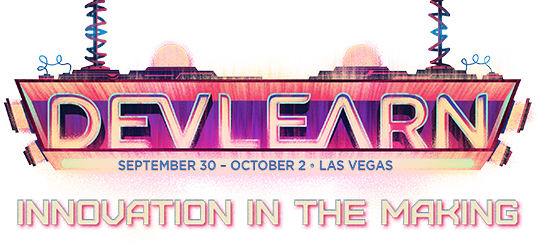Mark your calendars now for DevLearn 2016. Join us November 16 – 18, 2016, back at the MGM Grand in Las Vegas, NV!
DevLearn 2015 Concurrent Sessions
DevLearn 2015 offers you the largest, most comprehensive, most cutting-edge learning technologies program in the world. The program includes more than 125 concurrent sessions covering all the critical topics that will help you develop new skills and expertise in the management, design, and development of technology-based learning.
Look for B.Y.O.L.® Sessions!
![]() Bring Your Own Laptop® (B.Y.O.L.®) takes learning to the next level. In these sessions you will bring your mobile device or laptop, with the software being discussed installed, and have the unique opportunity to learn hands-on, following along with an instructor step-by-step.
Bring Your Own Laptop® (B.Y.O.L.®) takes learning to the next level. In these sessions you will bring your mobile device or laptop, with the software being discussed installed, and have the unique opportunity to learn hands-on, following along with an instructor step-by-step.
Filter By:
Sessions in Games and Gamification Track
111 Ten Projects Showcasing the Top 10 Reasons for Gamification
Concurrent Session
Gamification and games-based learning is a viable, effective strategy for learning and yet there is resistance when it comes to executive buy-in. We hear, “Gamification is too expensive!” “It’s too flashy!” “We don’t want our employees playing games on the job!” Turning the tide of perception takes a combination of highlighting programs in which gamification has been incredibly effective, understanding the science behind why gamification works so well for learners, and targeting those specific projects for which gamification is a perfect fit.
Read MoreThe power of games for learning is well documented, yet the thought of undertaking the design and development building of a game seems overwhelming due to the perceived cost and hours to learn how to do it. The time and the energy just seem too large of a barrier.
Read MoreIf you’re in the world of eLearning, it goes without saying that you’ve probably heard the term gamification thrown around quite a bit. But what does it mean for your eLearning projects? Is it as simple as leaderboards and badges? Fundamentally, gamification is about applying game elements and gaming techniques to otherwise static content, with the intention of making that content a little more fun, engaging, and impactful. These days, designing game elements and applying gaming techniques to eLearning content doesn’t have to require a lengthy design and development timeline, nor the use of complex programming tools.
Read MoreWhy do people spend hours learning how to master new levels in their favorite games? The answer to this question, and the ability to harness some of that excitement and magic for workplace learning, is why there is growing interest in games for learning.
Read More511 Getting Serious Organizations to Take Games Seriously
Concurrent Session
Often the idea of using instructional games is met with stiff resistance by project stakeholders and the organization’s leadership: “We don’t want our employees playing games! We are a serious organization with serious work to do!” So how do you design instructionally effective games for the workplace and gain buy-in from stakeholders and leadership in your organization?
Read MoreMany applications of gaming in learning simply encourage competitive or game behaviors—they lack a focus on true learning or underlying game dynamics. The game dynamics are what power the experience and include aspects of generosity, collaboration, sharing, trading, perspective, and power.
Read MoreYes, the interest in learning games has exploded, along with the interest in gamification. Many practitioners want to create digital game play experiences as opposed to “Click NEXT to continue” eLearning. But when you get started in digital, how do you do it? How “game-y” does something need to be to produce solid learner engagement while maintaining the integrity of the learning experience? What best practices should you follow, and what pitfalls should you avoid? How is the design process the same? How is it different?
Read More












































